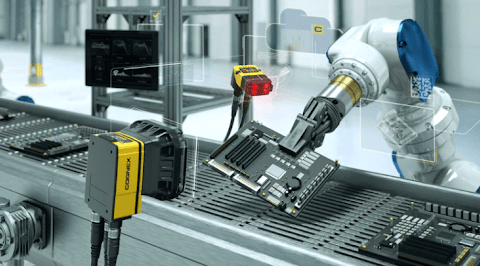
With the advent of digital vision technology, expanded sensor applications have also been gradually developed to meet the needs of manufacturers; Typically, RFID sensors integrate IoT or ToF (Time-of-Flight) sensors.
• RFID (Radio Frequency Identification) is a “radio frequency identification” technology that uses radio waves to transmit data from RFID tags (tags) to the RFID receiver. In line production, RFID systems are used to replace Kaban tags to help better control production lines, identify which semi-finished products are being processed at which stage and control progress over time thanks to IoT. The advantage of this technology lies in its ability to provide stable “visibility” in various environments such as snow, dirt, or high temperatures. RFID-integrated robots can also detect arising errors or semi-finished product backlog on the line during operation.
• ToF (Time-of-Flight) consists of a sensor that uses a small laser to emit infrared light to the object. The amount of time light is needed to reflect the sensor will be calculated and converted into information about the distance that can be used to model an object. Unlike conventional laser sensors, ToF is capable of determining the depth of the object with only one projection surface. In industry, the use of robots incorporating ToF sensors saves a lot of costs for manufacturers. Instead of having to set up a series of cameras or transceivers at many places on the line, they just need to use ToF to provide visibility to the robot while ensuring accuracy in the operation.
In addition to technology, the expansion of the VGR ecosystem is also a factor promoting the development of industrial robots. This ecosystem consists of 3 participants: Hardware suppliers (robots and cameras), Software vendors (management tools, connectivity tools, etc) and service providers (installation, system integration, etc). VGR serves a variety of industries through applications that extract, characterize and interpret information about an object, enabling process optimization and detecting related failures.
For hardware vendors, the camera is the most important factor that transforms a traditional robot into a robot capable of acting independently today. Mostly, robots are operated by integrating 2D and 3D vision. For example, in a beer production line, a 3D camera will locate and trace at random points while the 2D camera will scan the image in the remaining planes. Thanks to this combination, the actual distance, depth, deformation or even the position of the object on an active line will be accurately determined by the robot. On the other hand, random sampling also helps managers control the quality of a shipment.
If the VGR hardware is focused on data collection, the software will play the role of processing that data. How robots respond to the collected data is of utmost concern to software manufacturers. Today, thanks to the Internet of things and artificial intelligence, data can be analyzed and processed in real time. The Internet of Things provides an internal information exchange network that is operated continuously while fast artificial intelligence analyzes data to determine whether the process is operating normally. If any problems occur, the automatic robots will temporarily stop working to notify the person in charge or solve the problem themselves according to what has been set.
Under the impact of the Industrial Revolution 4.0, the cohesion between VGR and manufacturers has become more and more close. Competitive pressure is causing many manufacturers to convert to digitize and automate their businesses. The reduction of personnel to gradually replace the labor force with machines has become a trend in the 4.0 revolution. Therefore, 3D vision technology is promised to become a factor directing the development of the robot industry in particular and the whole industry in general in the near future.
Productivity and Quality Office